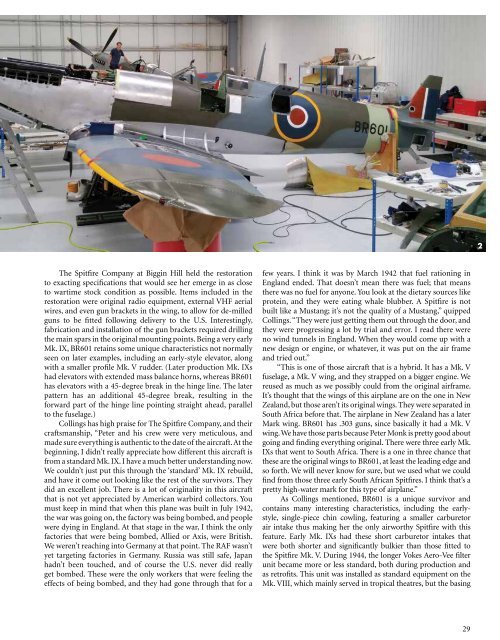WD74W2
Create successful ePaper yourself
Turn your PDF publications into a flip-book with our unique Google optimized e-Paper software.
2<br />
The Spitfire Company at Biggin Hill held the restoration<br />
to exacting specifications that would see her emerge in as close<br />
to wartime stock condition as possible. Items included in the<br />
restoration were original radio equipment, external VHF aerial<br />
wires, and even gun brackets in the wing, to allow for de-milled<br />
guns to be fitted following delivery to the U.S. Interestingly,<br />
fabrication and installation of the gun brackets required drilling<br />
the main spars in the original mounting points. Being a very early<br />
Mk. IX, BR601 retains some unique characteristics not normally<br />
seen on later examples, including an early-style elevator, along<br />
with a smaller profile Mk. V rudder. (Later production Mk. IXs<br />
had elevators with extended mass balance horns, whereas BR601<br />
has elevators with a 45-degree break in the hinge line. The later<br />
pattern has an additional 45-degree break, resulting in the<br />
forward part of the hinge line pointing straight ahead, parallel<br />
to the fuselage.)<br />
Collings has high praise for The Spitfire Company, and their<br />
craftsmanship, “Peter and his crew were very meticulous, and<br />
made sure everything is authentic to the date of the aircraft. At the<br />
beginning, I didn’t really appreciate how different this aircraft is<br />
from a standard Mk. IX. I have a much better understanding now.<br />
We couldn’t just put this through the ‘standard’ Mk. IX rebuild,<br />
and have it come out looking like the rest of the survivors. They<br />
did an excellent job. There is a lot of originality in this aircraft<br />
that is not yet appreciated by American warbird collectors. You<br />
must keep in mind that when this plane was built in July 1942,<br />
the war was going on, the factory was being bombed, and people<br />
were dying in England. At that stage in the war, I think the only<br />
factories that were being bombed, Allied or Axis, were British.<br />
We weren’t reaching into Germany at that point. The RAF wasn’t<br />
yet targeting factories in Germany. Russia was still safe, Japan<br />
hadn’t been touched, and of course the U.S. never did really<br />
get bombed. These were the only workers that were feeling the<br />
effects of being bombed, and they had gone through that for a<br />
few years. I think it was by March 1942 that fuel rationing in<br />
England ended. That doesn’t mean there was fuel; that means<br />
there was no fuel for anyone. You look at the dietary sources like<br />
protein, and they were eating whale blubber. A Spitfire is not<br />
built like a Mustang; it’s not the quality of a Mustang,” quipped<br />
Collings. “They were just getting them out through the door, and<br />
they were progressing a lot by trial and error. I read there were<br />
no wind tunnels in England. When they would come up with a<br />
new design or engine, or whatever, it was put on the air frame<br />
and tried out.”<br />
“This is one of those aircraft that is a hybrid. It has a Mk. V<br />
fuselage, a Mk. V wing, and they strapped on a bigger engine. We<br />
reused as much as we possibly could from the original airframe.<br />
It’s thought that the wings of this airplane are on the one in New<br />
Zealand, but those aren’t its original wings. They were separated in<br />
South Africa before that. The airplane in New Zealand has a later<br />
Mark wing. BR601 has .303 guns, since basically it had a Mk. V<br />
wing. We have those parts because Peter Monk is pretty good about<br />
going and finding everything original. There were three early Mk.<br />
IXs that went to South Africa. There is a one in three chance that<br />
these are the original wings to BR601, at least the leading edge and<br />
so forth. We will never know for sure, but we used what we could<br />
find from those three early South African Spitfires. I think that’s a<br />
pretty high-water mark for this type of airplane.”<br />
As Collings mentioned, BR601 is a unique survivor and<br />
contains many interesting characteristics, including the earlystyle,<br />
single-piece chin cowling, featuring a smaller carburetor<br />
air intake thus making her the only airworthy Spitfire with this<br />
feature. Early Mk. IXs had these short carburetor intakes that<br />
were both shorter and significantly bulkier than those fitted to<br />
the Spitfire Mk. V. During 1944, the longer Vokes Aero-Vee filter<br />
unit became more or less standard, both during production and<br />
as retrofits. This unit was installed as standard equipment on the<br />
Mk. VIII, which mainly served in tropical theatres, but the basing<br />
29


